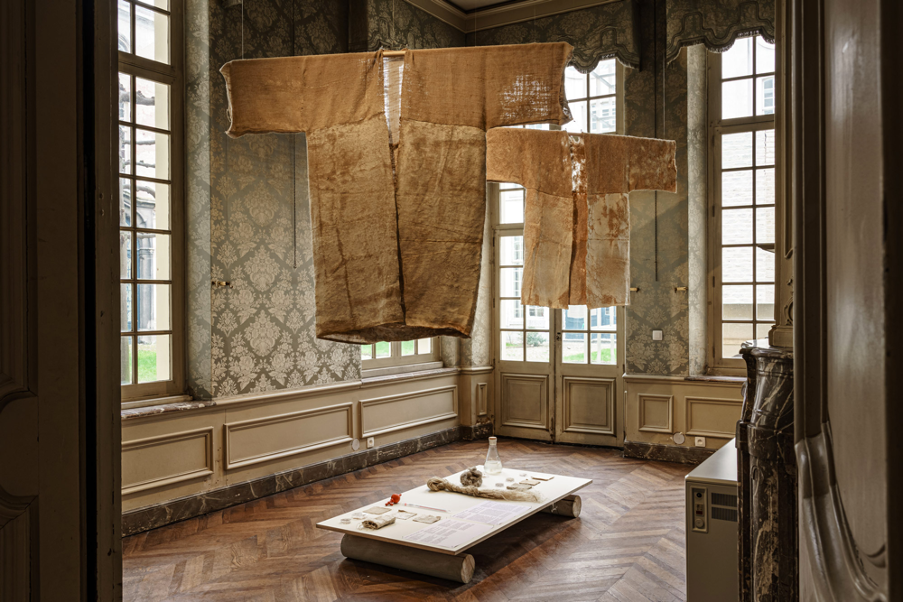Design Museum Gent in Belgium is currently hosting a unique exhibition called Home(Land), which showcases the work of Ukrainian and Dutch designers. The exhibition explores the topic of Home and homeland through the crossroad of cultures, combining traditional and modern techniques to find new forms using a variety of bio-materials such as clay, salt, wool, hemp, milk, buckwheat, and even mushrooms.
Due to Russia’s full-scale invasion, millions of Ukrainians were forced to leave their homes and found themselves far from their homeland. Can design help restore the feeling of a Home far from a physical one?
JOIN US ON TELEGRAM
Follow our coverage of the war on the @Kyivpost_official.
One of the project's authors, Dasha Tsapenko, moved from Ukraine to the Netherlands seven years ago to complete her master's degree. Since then, her practice has completely changed: “It was a jump from an architectural bureau to a bio-laboratory,” she says. Now she is a microbiology researcher at the University of Utrecht (Netherlands).
In response to the outbreak of the war, Dasha Tsapenko made the decision to teach art to Ukrainian refugee children living in the Netherlands. Through this experience, she gained deeper insight into the needs of her fellows and utilized this understanding to formulate the concept behind the Home(Land) exhibition:
“My move to the Netherlands for my studies facilitated a smooth and natural integration into Dutch society,” Tsapenko said. “However, families who arrived in the Netherlands due to the war had to undergo a sudden and disruptive transition from their homes to a new country. They were already uprooted from their homes, and it was challenging for them to instantly integrate into the new Dutch context.

Kyiv Camerata: From Carnegie Hall Back to Kyiv
“The Ukrainian culture is rich in daily domestic rituals that become inaccessible abroad, leading me to ponder the concept of ‘home.’ What constitutes a home? What makes a house a home? To explore this concept, we collaborated with our Dutch colleagues to combine our cultural contexts.”
The focal point of the exhibition centers around the Ukrainian gunya. The gunya is a traditional wool coat of shepherds in Ukraine. Nowadays, it is hardly used for its intended purpose, but it remains an essential ceremonial accessory, a family amulet passed down from generation to generation. Gunya symbolizes Home, safety and a place to hide.

Photo: Design Museum Gent
Dasha Tsapenko conducts experiments and research on the properties of mycelium, using hemp as the base. In her laboratory, she grows polypore mushrooms on various hemp fibers, to bind them together or imbue the already existing fabric with new characteristics, such as increased strength, improved insulation, and an intriguing organic pattern.
A major challenge the textile industry faces is water pollution caused by using toxic dyes. Dutch designer Ilsa Kraemer, known for her brand Fabulous Fungi, has cultivated a variety of fungi that produce natural color pigments safe for the environment. One of the gunias designed by Dasha Tsapenko and weaved by Ukrainian craftswoman Ruslana Goncharuk is dyed using these eco-friendly pigments.
Marjo van Schaik, the co-curator of Home(land), as well as one of the Dutch designer featured in the exhibition, has created several gunyas. Her work challenges the notion of waste by utilizing Dutch wool, often considered unsuitable for clothing due to its coarseness and tendency to cause discomfort.
In fact, many farmers dispose of sheep wool after shearing the animals, sometimes paying up to 100 to 150 euros to do so. Through her designs, van Schaik aims to bring attention to the potential of Dutch wool as a valuable resource in a sustainable fashion.
Each gunya featured in the exhibition is crafted from wool sourced from different farms and is imbued with its unique story. One of the gunias on display is dyed with natural dyes extracted from leftovers of ingredients of borscht, while another serves as a home for refugee seeds from the Ukrainian Seed Bank in Kharkiv.

Photo: Design Museum Gent
Jugs are also in the spotlight of the exhibition. Jugs serve as both a vessels for storage and forms of expression. Sietske Klooster and Oksana Denusevuch explore the anonymity of milk in the context of globalization in their project “Diversity in Milk(ing).” And Sasha Popruha and Stijn van Aardenne are 3D printing jugs made of starch and beeswax-based material from Ukrainian apiaries. These jugs are not only eco-friendly but also have a wonderful ‘flavor.’

Photo: Design Museum Ghent
Design Museum Gent is currently hosting the Home(Land) exhibition until April 30th, where visitors can witness these and other exhibits firsthand. Admission is free, but guests can donate to initiatives from the Koning Boudewijn Stichting, aimed to Ukranian citizens.
Home(Land) is a project by Dasha Tsapenko, Marjo Van Schaik, Fulco Treffers, Nazar Gresko and Olena Oranska.
Sponsors: BDO, Dutch Design Foundation, Embassy of Ukraine in The Netherlands, Dutch Embassy in Ukraine, Metalooms, Rotary, Creative Industries Fund NL, The New Block, Utrecht University, Donations through Voordekunst Crowdfunding including Prins Bernhard Cultuurfonds
You can also highlight the text and press Ctrl + Enter






